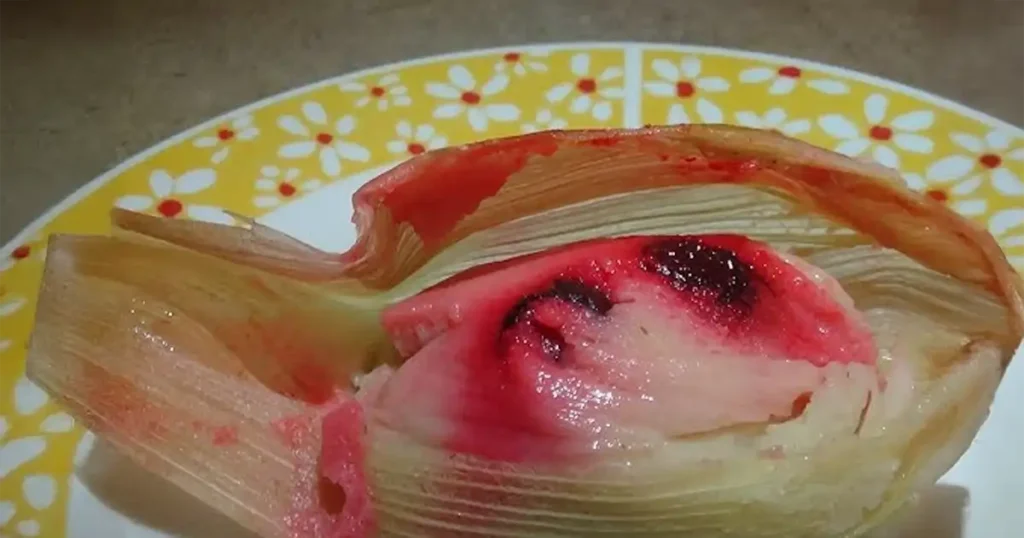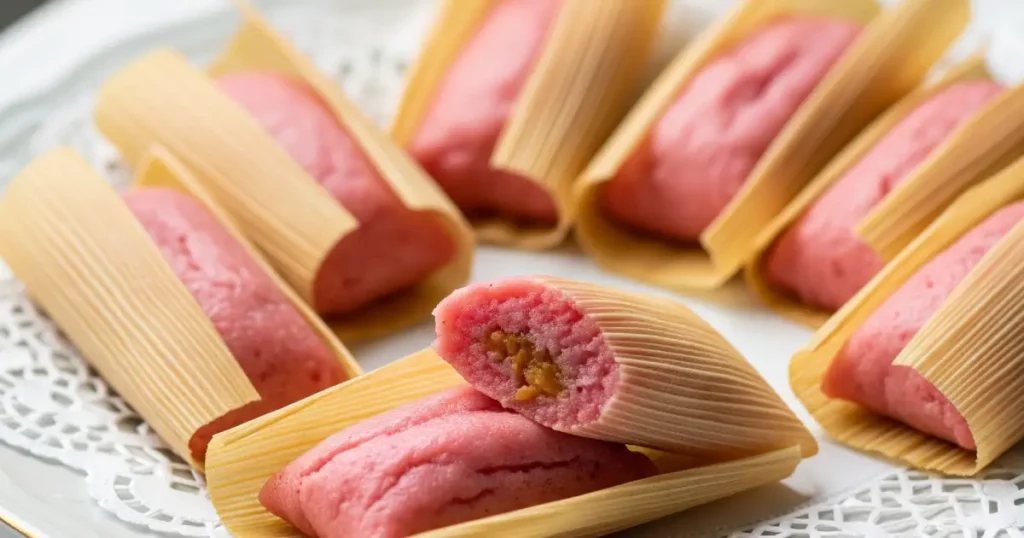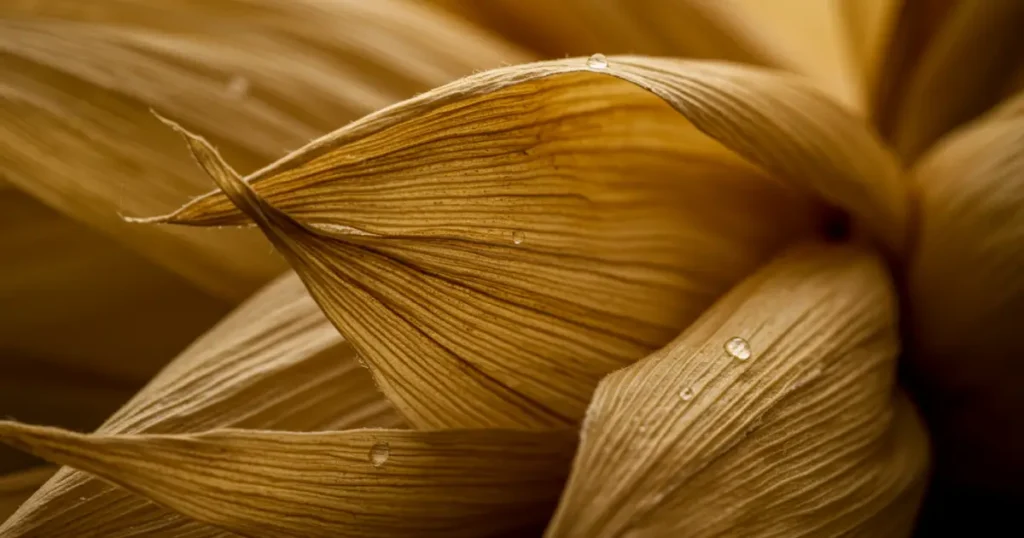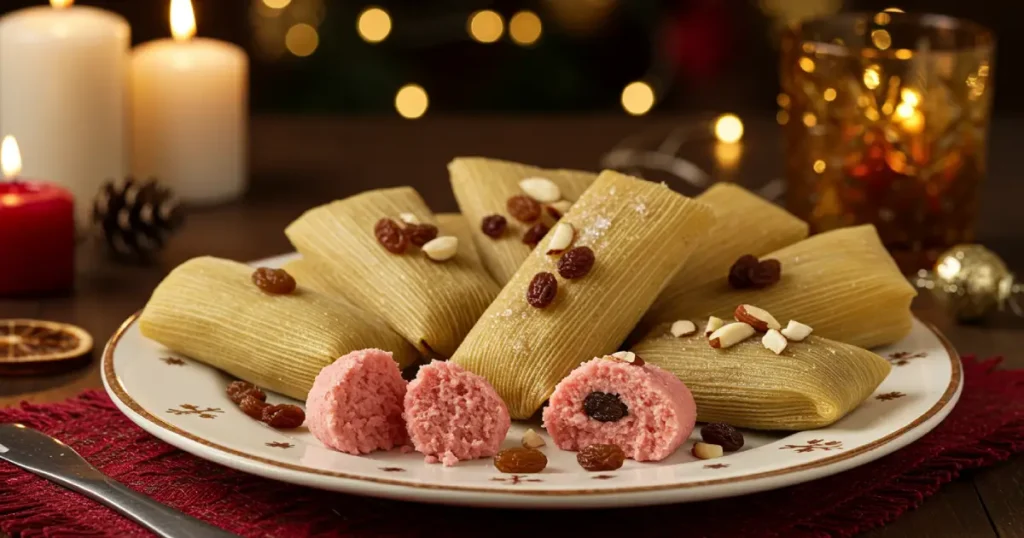Tamales de Cambray: Guatemala's Exquisite Sweet Dessert Tamal

Guatemala's culinary landscape is famed for its array of tamales, each with a unique story, flavor profile, and cultural significance. While savory tamales often take center stage, the world of Guatemalan sweets offers its own treasures, and among them, the Tamal de Cambray shines with a special, delicate allure.
These small, sweet tamales are not your everyday fare; they are dessert jewels, often gracing tables during festive occasions and celebrations, offering a taste of sweetness, tradition, and meticulous craftsmanship.
Unlike the hearty, savory tamales wrapped in plantain leaves or the rustic charm of Tamales de Elote, Tamales de Cambray are distinguished by their refined texture, sweet fillings, and petite size. They are a testament to the artistry in Guatemalan kitchens, transforming simple ingredients like rice flour or fine corn masa, sugar, and spices into elegant, bite-sized delights.
Join us as we unwrap the story of the Tamal de Cambray, exploring its unique characteristics, the loving process of its creation, its cherished place in Guatemalan festivities, and why it stands as a beloved confection.
What Defines a Tamal de Cambray?
The Tamal de Cambray, often referred to as "tamalitos de cambray" due to their small size, is primarily a dessert tamal. The name "Cambray" itself hints at something fine and delicate, possibly an allusion to cambric fabric, known for its fine, smooth quality, which mirrors the texture of these tamales.

Key Distinguishing Features:
- Delicate Masa: The foundation of a Tamal de Cambray is a smooth, almost custard-like masa. Traditionally, this can be made from finely ground rice flour (harina de arroz), or sometimes with cornstarch (maicena) or a very fine, specially prepared corn masa, often cooked with milk, butter, and sugar to create a rich, tender base. This contrasts sharply with the more robust, savory masa of other tamales.
- Sweetness and Aromatics: These tamales are unmistakably sweet. Sugar is a primary ingredient in the masa, and they are often perfumed with classic dessert spices like cinnamon and vanilla. Some recipes might also include subtle hints of anise or even a touch of rosewater for a floral note.
- Rich Fillings: One of the hallmarks of the Tamal de Cambray is its sweet filling. Common fillings include:
- Manjar Blanco: A sweet, creamy milk pudding or custard, similar to dulce de leche but often simpler, thickened with rice flour or cornstarch.
- Dried Fruits: Raisins and prunes are classic additions, offering bursts of concentrated sweetness and a pleasant chewiness.
- Nuts: Chopped almonds or other nuts may be included for texture.
- Red Color: Often, a part of the filling or even a streak in the masa is colored bright red with food coloring, adding a festive visual appeal. Historically, achiote might have been used for color in some regional variations, though for sweet dessert tamales, modern food coloring is more common for vibrant hues.
- Petite Size and Neat Wrapping: Tamales de Cambray are considerably smaller than most other Guatemalan tamales. They are typically wrapped neatly in tusas (dried corn husks), which are first soaked to become pliable. Their small size makes them perfect as individual dessert portions.
- Festive Association: While they can be enjoyed anytime one craves a special sweet treat, Tamales de Cambray are strongly associated with festive periods, particularly Christmas (Navidad), New Year's, and other significant family celebrations like baptisms or first communions.
The Exquisite Ingredients of Tamales de Cambray
Crafting these delicate tamales requires attention to detail and quality ingredients to achieve their signature taste and texture.

For the Masa:
- Rice Flour (Harina de Arroz): This is a common base, lending a distinct smoothness and tenderness. Some recipes might call for "crema de arroz," which is a very fine rice flour.
- Cornstarch (Maicena): Used either in conjunction with rice flour or sometimes as the primary thickener for the masa, contributing to its delicate, custard-like consistency.
- Fine Corn Masa: If corn masa is used, it's typically a very finely ground version, sometimes enriched and sweetened differently than savory masa.
- Milk: Whole milk is generally used to cook the flour or starch, creating a richer, creamier base than water.
- Butter (Mantequilla): Adds richness, flavor, and contributes to the smooth texture.
- Sugar (Azúcar): Essential for the sweetness of the masa itself.
- Flavorings: Ground cinnamon and vanilla extract are staples.
For the Filling:
- Manjar Blanco:
- Milk
- Sugar
- Rice flour or cornstarch (as a thickener)
- Cinnamon stick (to infuse flavor)
- Dried Fruits: Raisins and prunes are most traditional. Sometimes other finely chopped crystallized fruits might be used.
- Nuts: Almonds are a popular choice, often blanched and slivered or chopped.
- Red Food Coloring: Used sparingly to give a vibrant red or pink hue to a portion of the manjar or as a decorative element.
The Wrapping:
- Dried Corn Husks (Tusas): Selected for their pliability and size, these are soaked until soft.
The Artful Preparation of Tamales de Cambray: A Labor of Love
Making Tamales de Cambray is a meticulous process, often undertaken with care and dedication, reflecting the special nature of these treats.
Preparing the Sweet Filling (Manjar Blanco):
- Combine Ingredients: In a saucepan, combine milk, sugar, and the thickening agent (rice flour or cornstarch, often dissolved in a little cold milk first to prevent lumps). Add a cinnamon stick.
- Cook Slowly: Cook over medium-low heat, stirring constantly and patiently, until the mixture thickens to a very thick, custard-like consistency. This can take time, and constant stirring is crucial to prevent scorching and lumps.
- Cool: Once thickened, remove from heat, discard the cinnamon stick, and let it cool completely. The manjar will thicken further as it cools. If using red food coloring, a portion of the manjar can be mixed with a few drops.
Preparing the Masa:
- Combine Ingredients: In a heavy-bottomed saucepan, combine the rice flour (or cornstarch/fine masa), sugar, milk, melted butter, cinnamon, and vanilla. Whisk well to ensure there are no lumps.
- Cook the Masa: Place the saucepan over medium heat. Cook, stirring constantly and vigorously with a wooden spoon or spatula, until the mixture thickens considerably and starts to pull away from the sides of the pan. It should be a very thick, smooth, and glossy paste. This process requires patience and continuous stirring to prevent sticking and ensure even cooking.
- Cool Slightly: Remove the cooked masa from the heat and let it cool slightly, just enough so it can be handled.
Assembling the Tamales de Cambray:

- Prepare Husks: Select soaked, pliable corn husks. Pat them dry.
- Spread Masa: Take a corn husk and spread a small portion (about 1-2 tablespoons, depending on husk size) of the warm masa in the center, forming a small rectangle or oval. The layer of masa should be relatively thin.
- Add Filling: Place a small dollop of the cooled manjar blanco in the center of the masa. Add a few raisins, a piece of prune, and perhaps a tiny bit of the red-colored manjar or a sliver of almond. Don't overfill, as these are delicate.
- Wrap Neatly: Fold one long side of the corn husk over the filling, then the other side, overlapping them. Fold the pointed bottom end of the husk up, creating a small, neat rectangular packet. The top end can be folded down or left slightly open. Some traditions involve a specific tie with a thin strip of corn husk to secure the tamal and give it a distinctive look.
- Repeat: Continue until all the masa and filling are used.
Steaming the Tamales:
- Prepare Steamer: Set up a steamer pot (tamalera) with water in the bottom, below the level of the steamer rack. Line the rack with a layer of leftover corn husks.
- Arrange Tamales: Carefully arrange the Tamales de Cambray upright or lying flat (depending on their shape and your steamer) in the prepared steamer basket. If standing them, pack them snugly to support each other.
- Cover and Steam: Cover the tamales with another layer of corn husks and then a clean kitchen towel before placing the lid on the pot. This helps to create a good steam environment.
- Steaming Time: Bring the water to a boil, then reduce the heat to maintain a steady simmer. Steam the tamales for approximately 45 minutes to 1 hour. The exact time can vary based on their size and the steamer.
- Check for Doneness: To check, carefully remove one tamal. Let it cool for a few minutes. The masa should be firm and set, and it should pull away cleanly from the husk.
Cooling and Serving:
- Rest: Once cooked, turn off the heat and let the tamales rest in the steamer with the lid on for at least 20-30 minutes. This allows them to firm up properly.
- Serve: Tamales de Cambray are best served warm or at room temperature. They are unwrapped at the table and enjoyed as a delightful dessert.
Cultural Significance: The Festive Sweetness of Tamales de Cambray
Tamales de Cambray are much more than just a sweet treat; they are imbued with cultural significance and associated with joyous occasions.
The Quintessential Christmas Tamal:

In Guatemala, these tamales are particularly famous during the Christmas season (Navidad). Their sweetness, rich ingredients like dried fruits and nuts (often associated with holiday baking), and sometimes festive colors make them a perfect fit for Christmas Eve (Noche Buena) celebrations and other holiday gatherings. Making them is often a family tradition, passed down through generations, adding to the festive spirit.
Celebrations and Special Events:
Beyond Christmas, Tamales de Cambray are often prepared for other significant life events and celebrations:
- New Year's: To welcome the new year with sweetness.
- Baptisms and First Communions: Their delicate nature and sweetness make them suitable for children's religious celebrations.
- Weddings and Anniversaries: As a refined dessert option.
- Special Family Gatherings: Whenever a touch of elegance and tradition is desired.
Their presence signifies a special occasion, a time for indulgence and sharing cherished traditional flavors.
A Symbol of Hospitality and Craft:
Offering Tamales de Cambray to guests is a gesture of warm hospitality. The meticulous preparation involved also highlights the skill and dedication of the cook, making each tamal a small work of culinary art.
Regional Nuances:
While the core concept of a sweet, small tamal with fillings is consistent, there might be subtle regional variations in the exact ingredients for the masa, the specific combination of fillings, or the way they are wrapped and presented. These local touches add to the rich diversity of Guatemalan cuisine.
Tamales de Cambray in the Pantheon of Guatemalan Desserts
Guatemala boasts a wide array of traditional desserts (postres), from syrupy fruit preserves (conservas) and milk-based sweets (dulces de leche) to baked goods like champurradas and buñuelos. Tamales de Cambray hold a unique position within this sweet landscape.
- Comparison to Other Sweet Tamales: While Tamales de Elote are also sweet corn tamales, they are generally simpler, focusing on the freshness of the corn. Tamales de Cambray are more complex, with a cooked, enriched masa and distinct fillings, positioning them as a more elaborate dessert.
- Artisanal Quality: Like many traditional Guatemalan sweets, they often have an artisanal quality, especially when homemade or purchased from specialty bakers who honor traditional recipes.
Seeking Out and Savoring Tamales de Cambray
Finding authentic Tamales de Cambray can be a rewarding experience for those wishing to taste this unique Guatemalan confection.
- Seasonal Availability: They are most readily available during the Christmas holiday season. Look for them in traditional markets, specialty food shops, and from home-based vendors who advertise seasonal treats.
- Bakeries (Panaderías Tradicionales): Some traditional Guatemalan bakeries, especially those known for their wide range of pan dulce (sweet breads) and desserts, may offer them year-round or by special order.
- Festivals and Fairs: Local festivals or cultural fairs might feature vendors selling traditional foods, including these dessert tamales.
- Serving Suggestion: Enjoy them warm or at room temperature, perhaps accompanied by a cup of rich Guatemalan coffee or a traditional hot beverage like atol. Their small size makes them perfect for a refined dessert course or a special afternoon treat.
Why Tamales de Cambray Remain a Cherished Confection
The enduring charm of Tamales de Cambray lies in several factors:
- Exquisite Taste and Texture: The combination of the smooth, sweet, delicate masa and the rich, flavorful fillings is truly unique and delightful.
- Festive Spirit: They embody the joy and sweetness of celebrations, particularly Christmas.
- Artisanal Tradition: They represent a culinary craft, often passed down through families, preserving traditional techniques and flavors.
- A Touch of Elegance: Their petite size and careful preparation lend them an air of refinement compared to more rustic tamales.
The Tamal de Cambray is a beautiful expression of Guatemala's sweet culinary heritage. It’s a confection that invites you to slow down, savor the intricate flavors, and appreciate the love and tradition wrapped within each delicate corn husk. Whether you are fortunate enough to taste them in Guatemala during a festive season or inspired to try making them yourself, these dessert jewels offer a truly special glimpse into the heart of Guatemalan celebratory cuisine.

Leave a Reply